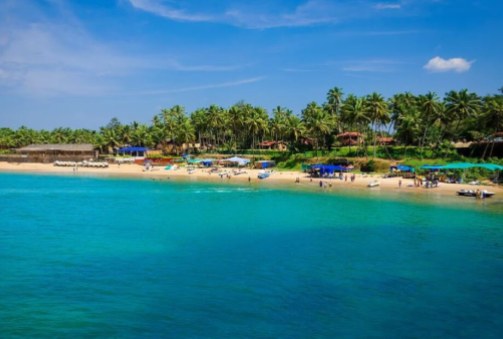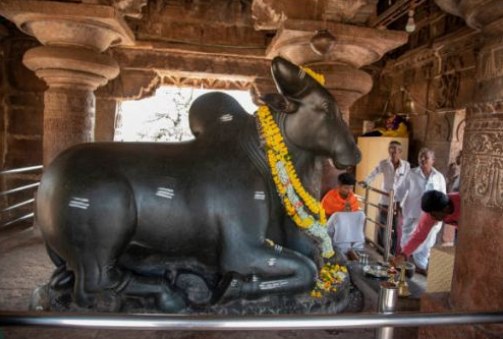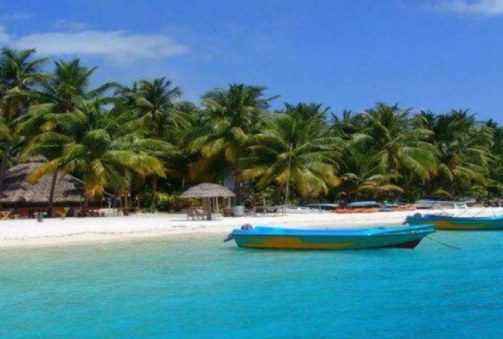All our tours are 100% customizable
Karnataka with Lakshadweep – 12 nights/13 days
Price to be reconfirmed – 990 Euro/pp minimum -02 persons
Goa-Hubbali-Badami-Hampi-Hassan-Mysore-Bangalore-Agatti-Bangaram-Agatti-Bengalore
Day 1 Arrive Goa
Arrival at Goa International Airport.
Once immigration procedures are completed and luggage collected, our representative will be waiting for you outside the Terminal to transfer you to the hotel.
Arrival at the hotel and check-in. Standard Check-in at 14:00 / Check out at 12:00.
Shantadurga Hindu Temple - Shri Shantadurga Temple is located at the foothills of Kavalem village in Ponda Taluka, Goa. A small laterite mud shrine was built and the deity was installed there.
Se Cathedral - Se Cathedral was built to commemorate the victory of Afonso Albuquerque, won on the feast of St. Catherine of Alexandria, this building is the largest church in Asia. It is the cathedral of the Archbishop of Goa.
Bom Jesus Basilica - The Bom Jesus Basilica is a World Heritage Site and was named as such by UNESCO. Its unplastered exterior may at first glance seem inferior to the glittering facades of churches like the Se Cathedral, but this small Basilica is rich in art, architecture and history, and houses the relics of St. Francis Xavier.
Latin Quarter of Fontainhas - The capital of Panjim's Latin Quarter, Fontainhas is known for its narrow streets lined with colorful Portuguese villas with balconies and red-tiled roofs.
Panjim - Visit the local market located in the capital city of Goa.
Overnight stay in Goa.

Day 2 Goa-Hubbali (192 Km, 4 hours 40 minutes)
After breakfast, drive to Hubbali.
On arrival at Hubbali transfer to hotel.
Chandramouleshwara Temple: - Chalukyas built this temple in the 11th and 12th centuries. The tales say that the Chalukyans wanted to boast of their splendid architecture and show off their power and wealth to their enemies. The tales say that the temple was built overnight by a group of anonymous artisans and sculptors. Since the temple was built in one night and since the artisans could not complete the entire work in one night, the structure of the temple is incomplete. Unlike other temples, the temple does not have a gopura.
Overnight stay in Hubbali.

Day 3 Hubbali-Badami (105 Km, 2 hours 40 minutes)
After breakfast, Departure for Badami.
Cave Temples:- The cave temples of Badami consist of four separate temples, each with intricate carvings and depictions. These carvings depict Shiva and Vishnu in various avatars in the first 3 temples, representing the Brahmanical style. The fourth temple is dedicated to Jain Tirthankaras. These beautiful red sandstone temples are a candidate for the UNESCO World Heritage List.
Badami Fort:- Badami Fort was built by the Chalukyan king Pulakeshi in 543 AD. Perched on top of a cliff, this fort is accompanied by two Shivalaya complexes dating back to the 5th century. A 16th century and a 14th century watchtower are also located on top of this hill. The Fort is located 500 meters from Badami bus stand.
Bhuthanatha Temples:- The two temples overlooking the Agastya Lake are known as the Bhuthanatha group of temples. To the east of the lake is the Bhuthanatha Temple and the temple to the north-east is the Mallikarjuna Temple. Built in local sandstone, they are dedicated to Lord Shiva, in the form of Bhuthanatha. The architecture resembles a typical South Indian temple. The sandstone used to build these temples gives them a beautiful hue that sparkles in the afternoon sun.
Banashankari Temple:- Banashankari Temple has a history of harmony, having been built and renovated in Dravidian and Nagara architectural styles. It has maintained its tradition of unity in the religious and cultural festival of Banashankari Jatre every January, where people from Karnataka and adjoining states flock to show their devotion and also witness in the cultural programs and fair.
Overnight stay at Badami.

Day 4 - Badami-Hampi (148 Km, 3 hours 40 minutes)
After breakfast the day begins.
Mahakuta Temples: - Situated on the outskirts of Badami, in the small village of Mahakuta, the Mahakuta group of temples is an architectural delight, mirroring the unique Chalukya rock-cut construction pattern seen throughout Badami.
Mallikarjuna Temple, a part of the Bhutanatha group of temples, is the second most important temple in the group. Situated on the north-eastern side of Agastya Lake, this temple has a stepped superstructure, a common feature of the architectural work of Kalyani Chalukyas.
After visiting Badami, departure for Hampi.
Overnight stay in Hampi.

Day 5 - Hampi
After breakfast the day begins.
Virupaksha Temple: - Virupaksha Temple is located in Hampi, Vijayanagara district, Karnataka, India. It is a part of the Hampi Group of Monuments, designated as a UNESCO World Heritage Site.
Shree Vijaya Vitthala Gudi:- This temple is famous for Stone Chariot and Musical Pillars. Vijaya Vittala or Vittala Temple is the most famous and popular tourist attraction in Hampi. It was built around 15th century AD during the reign of King Devaraya II (1422 - 1446 AD). This temple is dedicated to Lord Vishnu in the form of Vittala.
Hazara Raama Temple: - It was built in the early 15th century by the Vijayanagara king, Devaraya II, and was constructed as a simple structure. It consisted of only a shrine, a pillared hall and an Ardha mandapa. However, it was later renovated to an open portico and beautiful pillars.
Lakshmi Narasimha Temple: - Lakshmi Narasimha Temple was built in 1246 AD by Bommanna Dandanayaka, a commander of the Hoysala Empire during the reign of King Vira Someshwara. It is a good example of 13th century Hoysala architecture.
Elephant Stables: - The elephant stables of Hampi served as an enclosure for the royal elephants during the times of the Vijayanagra Empire. Here, one sees eleven domed chambers in a long row with one particularly ornate one that served as an enclosure for the musicians during performances.
Queen's Bathhouse: - Located 1 km from Kamalapur bus stand and 3 km from Hampi bus stand, Queen's Bath is located near the entrance to the Royal Enclosure in Hampi. The Queen's Bath is believed to have been built by Achyuta Raya for the women of the Vijayanagara royal family.
Lotus Mahal: - Lotus Mahal or Chitrangini Mahal is an important secular structure in Hampi, India. The Lotus Mahal is an example of Vijayanagara style architecture and is a two-storied structure built of rubble masonry and finely plastered. The structure was used as a residual place for the royal family of the Vijayanagara Empire.
Achyutaraya Temple: - Dedicated to Lord Thiruvengalanatha or Venkateshwara, this glorious temple in Hampi was built by the Vijaynagara ruler Achyuta Deva Raya. Due to its architectural finesse, this temple is one of the most popular tourist places to visit in Hampi. The Achyutaraya temple has two enclosures marked by Gopuras.
Overnight stay in Hampi.

Day 6 - Hampi-Chitradurga-Hassan (321 Km, 6 hours 20 minutes)
After breakfast, Departure for Hassan.
En route you will visit Chitradurg.
Chitradurga Fort: - Chitradurga Fort or Chitaldoorg as the British called it, is one of the major attractions of Chitradurga district. The fort was built between the 17th and 18th centuries by the ruling dynasties that include Chalukyas, Rashtrakutas, Hoysalas and Nayakas. The temple has been divided into upper fort and lower fort. The upper fort has 18 temples and there is a huge temple in the lower fort. The Hidimbeshwara Temple is the most interesting and the oldest among these temples.
Upon arrival in Hassan, transfer to the hotel.
Overnight in Hassan.

Day 7 - Hassan-Mysore (172 Km, 4 hrs)
After breakfast, depart for Mysore.
On arrival visit Mysore Palace: - Mysore Palace, also known as Amba Vilas Palace, is a historic palace and royal residence. It is located in Mysore, Karnataka. It was the official residence of the Wadiyar dynasty and the seat of the Kingdom of Mysore. The palace is located in the center of Mysore and faces the Chamundi Hills to the east. Mysore is commonly described as the "City of Palaces" and there are seven palaces including this one. However, Mysore Palace refers specifically to the one inside the new fort.
St. Philomena's Cathedral: - St. Philomena's Cathedral is a Catholic church that is the cathedral of the Diocese of Mysore, India. Its full name is St. Joseph and St. Philomena Cathedral. It is also known as St. Joseph's Cathedral. It was built in 1936 using a neo-Gothic style and its architecture was inspired by the Cologne Cathedral in Germany. This is one of the tallest churches in Asia.
Venugopala Swamy Temple: - Venugopala Swamy Templelocated at Hosa Kannambadi, near Krishna Raja Sagara, is an example of Hoysala architecture in Karnataka, India. This temple was built in the 12th century AD around the same time as the Chennakesava temple at Somanathapura in Mysore district.
Overnight stay in Mysore.

Day 8 - Mysore-Bangalore (150 Km 2 hours 50 minutes)
After breakfast, depart for Bangalore.
Bangalore Palace: This property was purchased by Rev. Garrett in 1873 AD from the British guardians of Maharaja Chamarajendra Wadiyar X, it was later transformed and renovated in 1881 as the residence of the young Maharaja.
ISKCON Temple: The construction of this majestic temple began in 1990. Six hundred skilled craftsmen spent more than 10 million man-hours to build this architectural marvel. The construction of the temple was subsequently completed in 1997.
Cubbon Park: Established in the year 1870, Sri Chamarajendra Park is a 'lung' area of Bengaluru city, located in the heart of the city in the central administrative area.
Nandi Temple: The Hindu temple is located inside a park called Bugle Rock. The bull referred to is a sacred Hindu demigod, known as Nandi; Nandi is a staunch devotee and assistant of Shiva.
Tipu's Summer Palace: A fine example of Indo-Islamic architecture was the summer residence of the mysterious ruler Tipu Sultan, the construction was started by Hyder Ali and completed in the year 1791.
Lalbagh Garden: Lal Bagh Botanical Garden is located in the southern part of Bangalore, it has a famous glass house dating back to 1889 that hosts two annual flower shows.
Overnight stay in Bangalore.

Day 9 - Bangalore-Agatti (By flight) Agatti-Bangaram (By boat)
After breakfast, depart for Laccadive (Bangaram)
Transfer to Bangalore airport as per flight schedule for Agatti.
On arrival at Agatti transfer to Bangaram by boat.
On arrival at Bangaram transfer to hotel.
Overnight stay at Bangaram.

Day 10 - Bangaram
After breakfast the day begins.
Free time.
Overnight stay at Bangaram.

Day 11 Bangaram
After breakfast the day begins.
Free time.
Overnight stay at Bangaram.

Day 12 - Bangaram-Agatti (By boat) Agatti-Bangalore (By flight)
After breakfast, depart for Bangalore.
Transfer to Agatti by boat.
Transfer to Agatti airport as per flight schedule for Bangalore.
Upon arrival in Bangalore transfer to hotel.
Overnight stay in Bangalore.

Day 13 - Bangalore-Next
Transfer to Bangalore airport.
Ciao India Tours wishes you a pleasant journey.
Inclusions:
- 12 nights’ accommodation in 3 star/Heritage hotels with breakfast (Full board in Bangaram), including all existing taxes.
- All transfers from the airport/station/port to the hotel and vice versa as per program.
- All transfers as per program with large air-conditioned car.
- Meet and assist upon arrival by our representative at the airport.
- Full board in Laccadive.
- The flight Bangalore and Agatti.
- The boat from Agatti to Bangaram.
- The boat from Bangaram to Agatti.
- The flight from Agatti to Bangalore.
- One bottle of water per person every day.
- All taxes included.
- Toll, Parking, Fuel, Driver's accommodation.
Exclusions:
- Visa, International flight, Health insurance, cancellation/change of flights, trains, Alcoholic beverages, Tips, Tour guide Tickets for monuments and activities, personal expenses, Camera etc.
- Everything that is not included in the inclusions.















